Human Eye and Colourful World class 10 notes
Class 10 Complete Notes | Defects of Vision, Dispersion, Scattering & Atmospheric Phenomena
What You’ll Learn:
1 Structure of Human Eye
Key Parts and Functions
- Cornea: Transparent front layer that refracts light (fixed focus)
- Iris: Colored muscle controlling pupil size (like camera aperture)
- Pupil: Adjustable opening regulating light entry
- Lens: Flexible convex lens for fine focusing (accommodation)
- Retina: Light-sensitive layer with rods (dim light) and cones (color)
- Ciliary Muscles: Adjust lens curvature for focusing

Fig 1.1: Human Eye Anatomy
Working Mechanism
Light travels through the eye in this sequence:
- Light enters through cornea (major refraction)
- Passes through pupil (size adjusted by iris)
- Lens fine-tunes focus via ciliary muscles
- Forms inverted image on retina
- Optical nerves send signals to brain, which interprets upright image
Fun Fact: The eye’s lens focal length can change from ~15mm (distant objects) to ~12mm (near objects).
2 Defects of Vision and Correction
Myopia (Nearsightedness)
Causes:
- Eyeball too long
- Lens too curved
- Image forms before retina
Correction:
- Concave lens diverges light before it enters eye
- Power formula: P = -1/f (negative for concave)
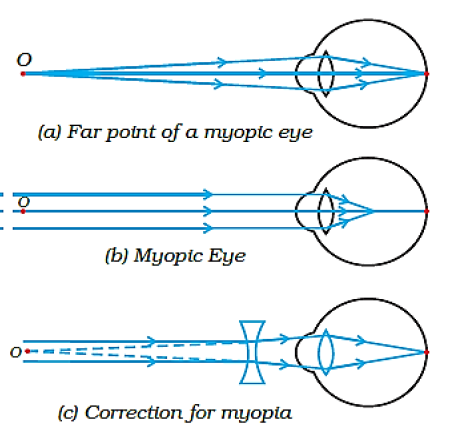
Hypermetropia (Farsightedness)
Causes:
- Eyeball too short
- Lens too flat
- Image forms behind retina
Correction:
- Convex lens converges light before it enters eye
- Power formula: P = +1/f (positive for convex)
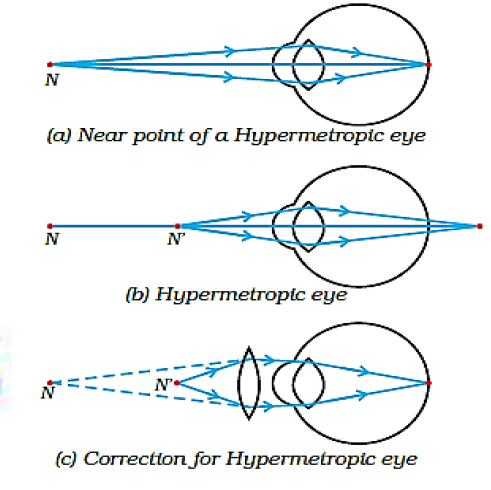
Presbyopia
- Age-related (usually after 40 years)
- Ciliary muscles weaken, lens hardens
- Loss of accommodation power
- Corrected with bifocal lenses (upper concave, lower convex)
Astigmatism
- Irregular cornea curvature
- Causes blurred vision at all distances
- Corrected with cylindrical lenses
Numerical: Lens Power Calculation
Problem: A myopic person’s far point is 80 cm. What lens power is needed for distant vision?
Given: Far point (v) = -80 cm (image at far point), u = ∞ (distant object)
Using lens formula: 1/f = 1/v – 1/u = 1/(-80) – 1/∞ = -1/80
Power P = 1/f (in meters) = -1/0.8 = -1.25 D
Solution: Concave lens of -1.25 diopters needed.
3 Dispersion of Light
What is Dispersion?
The splitting of white light into its constituent colors (VIBGYOR) due to:
- Different wavelengths refract at different angles
- Violet bends most (highest refractive index in glass)
- Red bends least
Refractive index (n) ∝ 1/λ (wavelength)

Fig 3.1: Dispersion through prism
Why Rainbow Shows Circular Shape?
Rainbows appear circular because:
- Sunlight enters raindrops and undergoes dispersion + total internal reflection
- Light exits at ~42° angle from incoming direction
- All drops at this angle form a cone with observer at vertex
- We see a semicircle when on ground (full circle from aircraft)
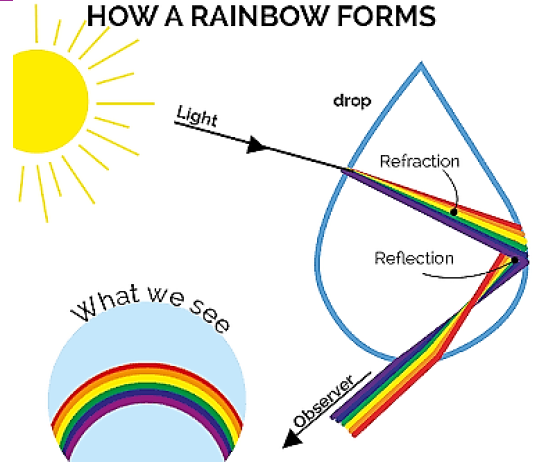

4 Scattering of Light
Rayleigh Scattering
Scattering of light by particles smaller than wavelength (e.g., air molecules):
- Intensity ∝ 1/λ⁴ (Violet scatters ~10× more than red)
- Causes blue sky and red sunrises/sunsets
- Explains why danger signals are red (least scattered)
Scattering ∝ 1/(wavelength)⁴
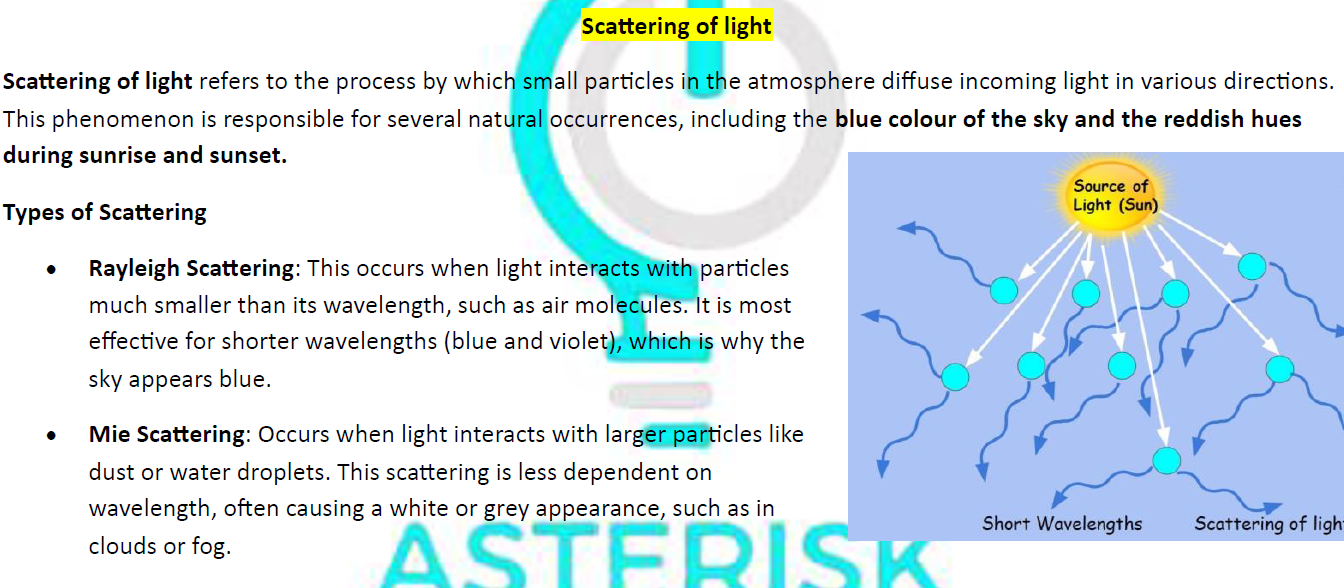
Why Sky is Blue?
- Sunlight reaches Earth’s atmosphere
- Air molecules scatter shorter (blue) wavelengths more
- Our eyes receive this scattered blue light from all directions
Why Sun Appears Red at Sunset?
- Sunlight passes through thicker atmosphere
- Most blue light scattered away
- Mainly longer (red/orange) wavelengths reach our eyes
5 Atmospheric Optical Phenomena
Tyndall Effect
- Scattering by colloidal particles (e.g., fog, milk)
- Path of light becomes visible
- Example: Blue appearance of smoke, headlight beams in fog
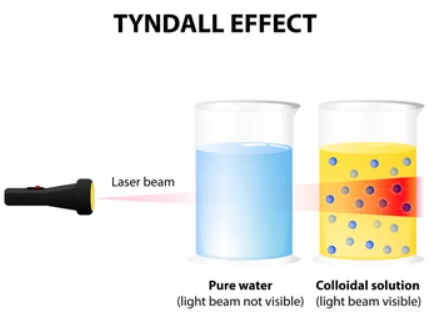
Twinkling of Stars
- Caused by atmospheric refraction
- Starlight bends through layers of varying density
- Planets don’t twinkle as they’re closer (larger apparent size)
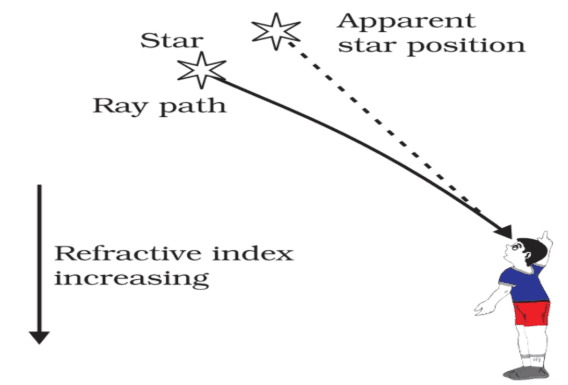
Advanced Sunrise & Delayed Sunset
Due to atmospheric refraction:
- Advanced Sunrise: Sun appears 2 mins before actual sunrise
- Delayed Sunset: Sun remains visible ~2 mins after actual sunset
- Total daylight increases by ~4 mins daily due to this
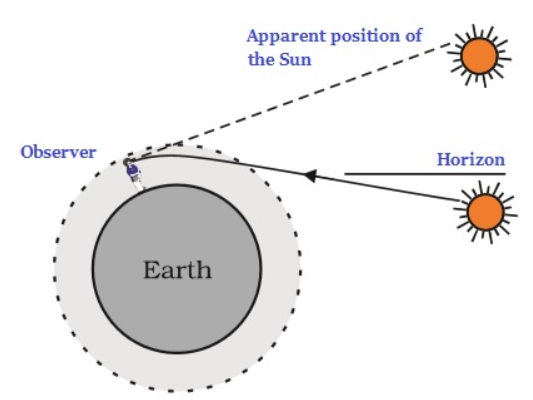
FAQs & Summary
Frequently Asked Questions
Why do stars twinkle but planets don’t?
Stars twinkle due to atmospheric refraction of their point-sized light. Planets appear as discs (larger angular size), averaging out refraction effects.
What is the difference between myopia and hypermetropia?
| Feature | Myopia | Hypermetropia |
|---|---|---|
| Far Point | Closer than infinity | Infinity (but near point >25cm) |
| Lens Used | Concave | Convex |
Chapter Summary
- Human Eye: Cornea (max refraction), lens (accommodation), retina (rods/cones)
- Defects: Myopia (-ve lens), Hypermetropia (+ve lens), Presbyopia (bifocals)
- Dispersion: VIBGYOR spectrum via prism (violet bends most)
- Scattering: Rayleigh (blue sky), Tyndall (colloids)
- Phenomena: Twinkling, advanced sunrise (atmospheric refraction)
Exam Tips
- Memorize lens power signs: Myopia (-ve), Hypermetropia (+ve)
- Rainbow angle: 42° from anti-solar point
- Scattering order: Violet > Blue > … > Red
Need printable notes with practice questions?


